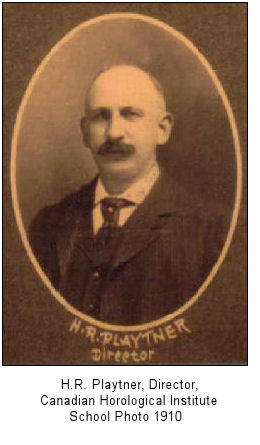
Henry R. Playtner 1864 - 1943


Henry R. Playtner was born Henry Richard Ploethner in Preston, Ontario on December 18, 1864 to immigrant parents August Ploethner and Martha Heise. At some point in his late teens or early twenties, Henry changed his surname to Playtner perhaps to have the spelling reflect the proper pronouniciation of the name.
Henry's watchmaking career began in 1880 at the age of 15 when he relocated to Kincardine, Ontario to apprentice with jeweller Edward Fox. Henry remained there until February of 1886. He then moved to Toronto where he worked for Robert Cuthbert at 9 King St. W for one month. Next Henry entered the employ of Kent Bros. at 168 Yonge Street from May of 1886 to September of 1887. Following this Henry was employed by John P. Mill 445 1/2 Yonge Street until May 1890.
By May of 1890, Henry and fellow jeweller Edward Beeton embarked upon a plan to start the first Horological School in Canada. The school opened in June 1890 in Toronto, Ontario. The partnership of Playtner and Beeton was brief. By August 11, 1890, Mr. Beeton had left the venture. Henry Playtner continued to operate the Canadian Horological Institute until the doors closed in 1913.
Letter to Editor March 13, 1890 Trader's Magazine Ad June 1896 16 Peter Street, Kitchener, ON
Final location of the Canadian Horological Institute
|
The school was first located directly opposite the property of St. James Cathedral in Toronto on the second floor of 133 King Street East. It opened with two students: J. Kincaid of Chicago and A. Zilliax of Listowel. By 1895 larger quarters were required. The school moved in August 1895 to the second floor of the Oak Building at 115 - 121 King Street East, Toronto. By 1907 the school once again required larger quarters. Accommodation was constructed at the southwest corner of Church and Wellesley Streets in Toronto.
Henry Playtner and the Canadian Horological Institute were internationally recognized. It is estimated that 50% of the students of the school came from outside Canada. The students were so well trained that in a competition for watchmakers sponsored by the Faneuil Watch Tool Company in 1897 and judged by the Philadelphia Horological Society, Playtner’s students took the top three prizes.
Henry Playtner wrote a lecture for the Canadian Watchmakers' and Retail Jewelers' Association of Canada entitled "An Analysis of the Lever Escapement". It was then published as a series of articles in the American Jeweler and subsequently turned into a hard covered book which is still in print today. Playtner’s book, The Analysis of the Lever Escapement, brought him international acclaim.
The American Jeweler wrote: “….Some of the most skillful watchmakers today have paid him the very high compliment of pronouncing his work the best essay on the subject that has ever been written.”
The British Horological Journal wrote: “Mr. Playtner, Director of the Canadian Horological Institute at Toronto, has issued a really excellent manual on the lever escapement…… It also affords evidence that the school is presided over by an able teacher and thoroughly practical horologist.”
From Germany, the Deutsche Uhrmacher Zeitung stated: “In this volume, the detached lever escapement is, so to say, brought under an intellectual microscope…. The different forms of lever forks and fork and roller actions are subjected to a keen criticism….”
Upon his death, the British Horological Journal referred to Playtner as the “brilliant, internationally-known Canadian horologist”. It went on to say “In addition to his far reaching reputation as an instructor, his “Analysis of the Lever Escapement”, published many years ago, is known to the students of the craft everywhere”.
Playtner’s legacy may be felt even today. His book on the lever escapement was re-printed in 1995 and is in constant demand. The text is available as an e-book on the Internet.
In 1923 Henry puchased a home at 16 Peter Street in Kitchener, Ontario. In later years, he developed severe diabetes. He died in his home of a stroke on September 20, 1943 at the age of 78. He is buried at the Old Preston Cemetery in what is now Cambridge, Ontario. Obituary.
Following is a list of students known to have attended Henry Playtner's Canadian Horological Institute. Information regarding any of these individuals would be greatly appreciated to assist with a current research project. Please contact us at if you can help!
R.J. Agnew
George G. Beall
Francis Bentley (London, England)
George F. Caven
Harold M. Caven
George Edmund Gendron (Penetanguishine, ON)
George Gilpin (Vancouver, BC)
W.E. Hagel
Levi Walpole Hodgins (Hamilton, ON)
Arnold Jansen (Elmira, ON)
John H. Kincaid (Chicago, IL)
George G. Koeberle (Sumner, IA and Los Angeles, CA)
A.C. Liphart
George G. Nettleton
H.G. Odell
Charles W. Parker (Nunda, NY)
L.A. Perret
N.S. Porter
Albert D. Savage (Guelph, ON)
Joseph J. Schuster (Cleveland, OH)
Jerry Smith (Richmond Hill, ON)
W.D. Smith
W.L. Smith (Nelson, BC)
Fred H. Spriggs
Eleanor Taylor - Born 4 Mar 1892 in Paisley, Bruce County, Ontario. Married Dr. James Bryce Brown.
Edward Teffein
Jacob Thuman (Evansville, IN)
Lorne Totton
Erle Surrey Walker (Calgary, AB)
C.K. Weaver
J.T. Whelan